Kailin Li
ManipTrans: Efficient Dexterous Bimanual Manipulation Transfer via Residual Learning
Mar 27, 2025
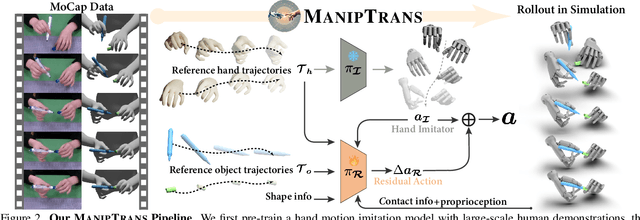


Abstract:Human hands play a central role in interacting, motivating increasing research in dexterous robotic manipulation. Data-driven embodied AI algorithms demand precise, large-scale, human-like manipulation sequences, which are challenging to obtain with conventional reinforcement learning or real-world teleoperation. To address this, we introduce ManipTrans, a novel two-stage method for efficiently transferring human bimanual skills to dexterous robotic hands in simulation. ManipTrans first pre-trains a generalist trajectory imitator to mimic hand motion, then fine-tunes a specific residual module under interaction constraints, enabling efficient learning and accurate execution of complex bimanual tasks. Experiments show that ManipTrans surpasses state-of-the-art methods in success rate, fidelity, and efficiency. Leveraging ManipTrans, we transfer multiple hand-object datasets to robotic hands, creating DexManipNet, a large-scale dataset featuring previously unexplored tasks like pen capping and bottle unscrewing. DexManipNet comprises 3.3K episodes of robotic manipulation and is easily extensible, facilitating further policy training for dexterous hands and enabling real-world deployments.
Hydra-MDP++: Advancing End-to-End Driving via Expert-Guided Hydra-Distillation
Mar 17, 2025Abstract:Hydra-MDP++ introduces a novel teacher-student knowledge distillation framework with a multi-head decoder that learns from human demonstrations and rule-based experts. Using a lightweight ResNet-34 network without complex components, the framework incorporates expanded evaluation metrics, including traffic light compliance (TL), lane-keeping ability (LK), and extended comfort (EC) to address unsafe behaviors not captured by traditional NAVSIM-derived teachers. Like other end-to-end autonomous driving approaches, \hydra processes raw images directly without relying on privileged perception signals. Hydra-MDP++ achieves state-of-the-art performance by integrating these components with a 91.0% drive score on NAVSIM through scaling to a V2-99 image encoder, demonstrating its effectiveness in handling diverse driving scenarios while maintaining computational efficiency.
Hydra-MDP: End-to-end Multimodal Planning with Multi-target Hydra-Distillation
Jun 11, 2024

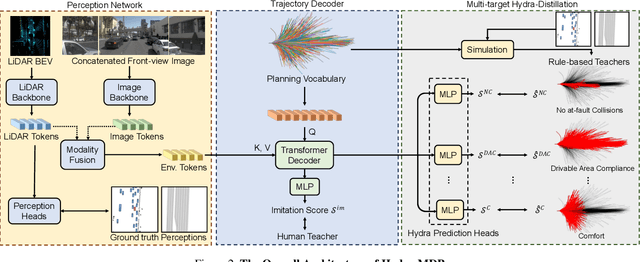

Abstract:We propose Hydra-MDP, a novel paradigm employing multiple teachers in a teacher-student model. This approach uses knowledge distillation from both human and rule-based teachers to train the student model, which features a multi-head decoder to learn diverse trajectory candidates tailored to various evaluation metrics. With the knowledge of rule-based teachers, Hydra-MDP learns how the environment influences the planning in an end-to-end manner instead of resorting to non-differentiable post-processing. This method achieves the $1^{st}$ place in the Navsim challenge, demonstrating significant improvements in generalization across diverse driving environments and conditions. Code will be available at \url{https://github.com/woxihuanjiangguo/Hydra-MDP}
SemGrasp: Semantic Grasp Generation via Language Aligned Discretization
Apr 04, 2024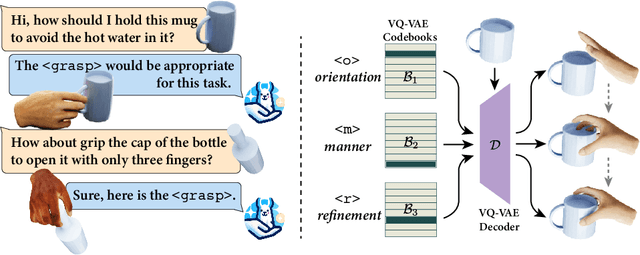
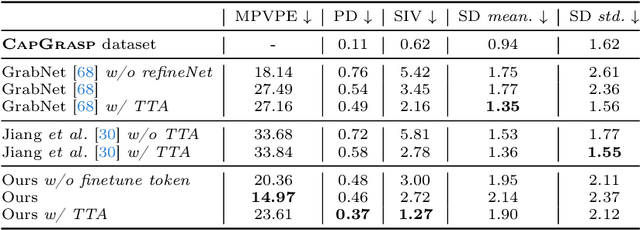


Abstract:Generating natural human grasps necessitates consideration of not just object geometry but also semantic information. Solely depending on object shape for grasp generation confines the applications of prior methods in downstream tasks. This paper presents a novel semantic-based grasp generation method, termed SemGrasp, which generates a static human grasp pose by incorporating semantic information into the grasp representation. We introduce a discrete representation that aligns the grasp space with semantic space, enabling the generation of grasp postures in accordance with language instructions. A Multimodal Large Language Model (MLLM) is subsequently fine-tuned, integrating object, grasp, and language within a unified semantic space. To facilitate the training of SemGrasp, we have compiled a large-scale, grasp-text-aligned dataset named CapGrasp, featuring about 260k detailed captions and 50k diverse grasps. Experimental findings demonstrate that SemGrasp efficiently generates natural human grasps in alignment with linguistic intentions. Our code, models, and dataset are available publicly at: https://kailinli.github.io/SemGrasp.
OAKINK2: A Dataset of Bimanual Hands-Object Manipulation in Complex Task Completion
Mar 28, 2024



Abstract:We present OAKINK2, a dataset of bimanual object manipulation tasks for complex daily activities. In pursuit of constructing the complex tasks into a structured representation, OAKINK2 introduces three level of abstraction to organize the manipulation tasks: Affordance, Primitive Task, and Complex Task. OAKINK2 features on an object-centric perspective for decoding the complex tasks, treating them as a sequence of object affordance fulfillment. The first level, Affordance, outlines the functionalities that objects in the scene can afford, the second level, Primitive Task, describes the minimal interaction units that humans interact with the object to achieve its affordance, and the third level, Complex Task, illustrates how Primitive Tasks are composed and interdependent. OAKINK2 dataset provides multi-view image streams and precise pose annotations for the human body, hands and various interacting objects. This extensive collection supports applications such as interaction reconstruction and motion synthesis. Based on the 3-level abstraction of OAKINK2, we explore a task-oriented framework for Complex Task Completion (CTC). CTC aims to generate a sequence of bimanual manipulation to achieve task objectives. Within the CTC framework, we employ Large Language Models (LLMs) to decompose the complex task objectives into sequences of Primitive Tasks and have developed a Motion Fulfillment Model that generates bimanual hand motion for each Primitive Task. OAKINK2 datasets and models are available at https://oakink.net/v2.
CHORD: Category-level Hand-held Object Reconstruction via Shape Deformation
Aug 21, 2023



Abstract:In daily life, humans utilize hands to manipulate objects. Modeling the shape of objects that are manipulated by the hand is essential for AI to comprehend daily tasks and to learn manipulation skills. However, previous approaches have encountered difficulties in reconstructing the precise shapes of hand-held objects, primarily owing to a deficiency in prior shape knowledge and inadequate data for training. As illustrated, given a particular type of tool, such as a mug, despite its infinite variations in shape and appearance, humans have a limited number of 'effective' modes and poses for its manipulation. This can be attributed to the fact that humans have mastered the shape prior of the 'mug' category, and can quickly establish the corresponding relations between different mug instances and the prior, such as where the rim and handle are located. In light of this, we propose a new method, CHORD, for Category-level Hand-held Object Reconstruction via shape Deformation. CHORD deforms a categorical shape prior for reconstructing the intra-class objects. To ensure accurate reconstruction, we empower CHORD with three types of awareness: appearance, shape, and interacting pose. In addition, we have constructed a new dataset, COMIC, of category-level hand-object interaction. COMIC contains a rich array of object instances, materials, hand interactions, and viewing directions. Extensive evaluation shows that CHORD outperforms state-of-the-art approaches in both quantitative and qualitative measures. Code, model, and datasets are available at https://kailinli.github.io/CHORD.
Color-NeuS: Reconstructing Neural Implicit Surfaces with Color
Aug 14, 2023Abstract:The reconstruction of object surfaces from multi-view images or monocular video is a fundamental issue in computer vision. However, much of the recent research concentrates on reconstructing geometry through implicit or explicit methods. In this paper, we shift our focus towards reconstructing mesh in conjunction with color. We remove the view-dependent color from neural volume rendering while retaining volume rendering performance through a relighting network. Mesh is extracted from the signed distance function (SDF) network for the surface, and color for each surface vertex is drawn from the global color network. To evaluate our approach, we conceived a in hand object scanning task featuring numerous occlusions and dramatic shifts in lighting conditions. We've gathered several videos for this task, and the results surpass those of any existing methods capable of reconstructing mesh alongside color. Additionally, our method's performance was assessed using public datasets, including DTU, BlendedMVS, and OmniObject3D. The results indicated that our method performs well across all these datasets. Project page: https://colmar-zlicheng.github.io/color_neus.
DART: Articulated Hand Model with Diverse Accessories and Rich Textures
Oct 14, 2022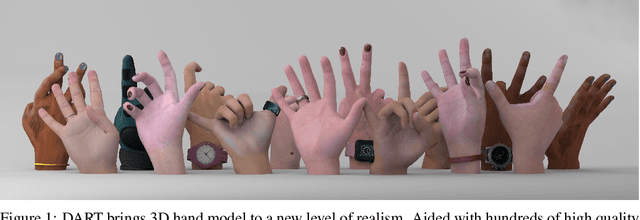

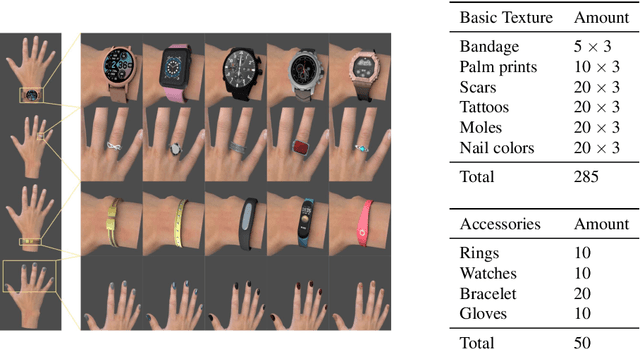

Abstract:Hand, the bearer of human productivity and intelligence, is receiving much attention due to the recent fever of digital twins. Among different hand morphable models, MANO has been widely used in vision and graphics community. However, MANO disregards textures and accessories, which largely limits its power to synthesize photorealistic hand data. In this paper, we extend MANO with Diverse Accessories and Rich Textures, namely DART. DART is composed of 50 daily 3D accessories which varies in appearance and shape, and 325 hand-crafted 2D texture maps covers different kinds of blemishes or make-ups. Unity GUI is also provided to generate synthetic hand data with user-defined settings, e.g., pose, camera, background, lighting, textures, and accessories. Finally, we release DARTset, which contains large-scale (800K), high-fidelity synthetic hand images, paired with perfect-aligned 3D labels. Experiments demonstrate its superiority in diversity. As a complement to existing hand datasets, DARTset boosts the generalization in both hand pose estimation and mesh recovery tasks. Raw ingredients (textures, accessories), Unity GUI, source code and DARTset are publicly available at dart2022.github.io
OakInk: A Large-scale Knowledge Repository for Understanding Hand-Object Interaction
Mar 29, 2022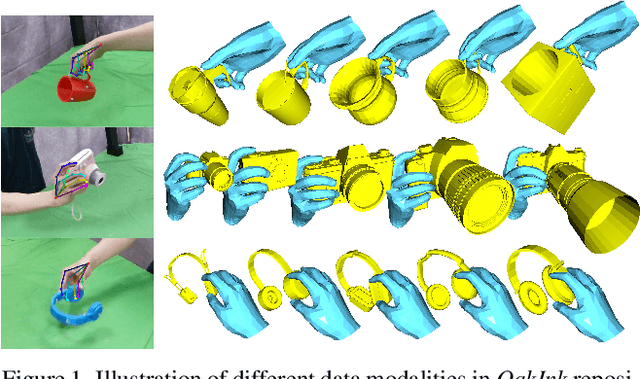

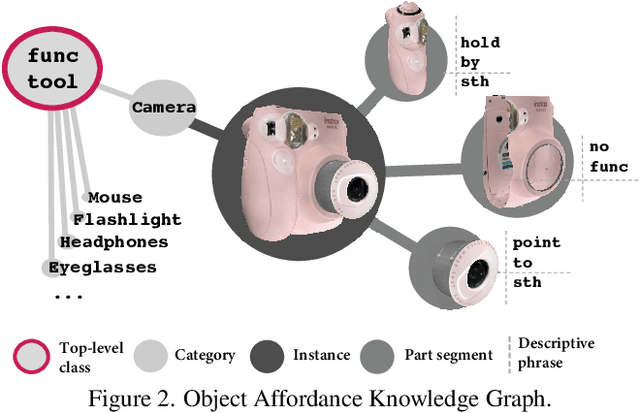
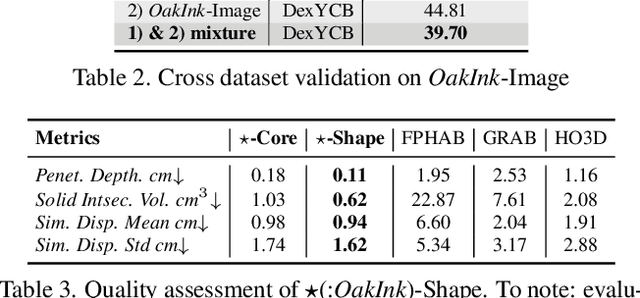
Abstract:Learning how humans manipulate objects requires machines to acquire knowledge from two perspectives: one for understanding object affordances and the other for learning human's interactions based on the affordances. Even though these two knowledge bases are crucial, we find that current databases lack a comprehensive awareness of them. In this work, we propose a multi-modal and rich-annotated knowledge repository, OakInk, for visual and cognitive understanding of hand-object interactions. We start to collect 1,800 common household objects and annotate their affordances to construct the first knowledge base: Oak. Given the affordance, we record rich human interactions with 100 selected objects in Oak. Finally, we transfer the interactions on the 100 recorded objects to their virtual counterparts through a novel method: Tink. The recorded and transferred hand-object interactions constitute the second knowledge base: Ink. As a result, OakInk contains 50,000 distinct affordance-aware and intent-oriented hand-object interactions. We benchmark OakInk on pose estimation and grasp generation tasks. Moreover, we propose two practical applications of OakInk: intent-based interaction generation and handover generation. Our datasets and source code are publicly available at https://github.com/lixiny/OakInk.
ArtiBoost: Boosting Articulated 3D Hand-Object Pose Estimation via Online Exploration and Synthesis
Sep 12, 2021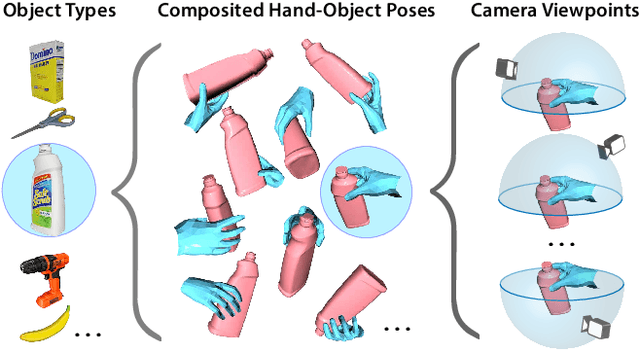
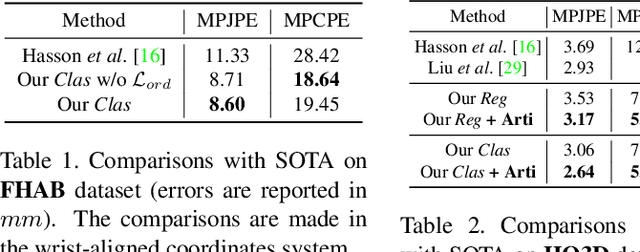
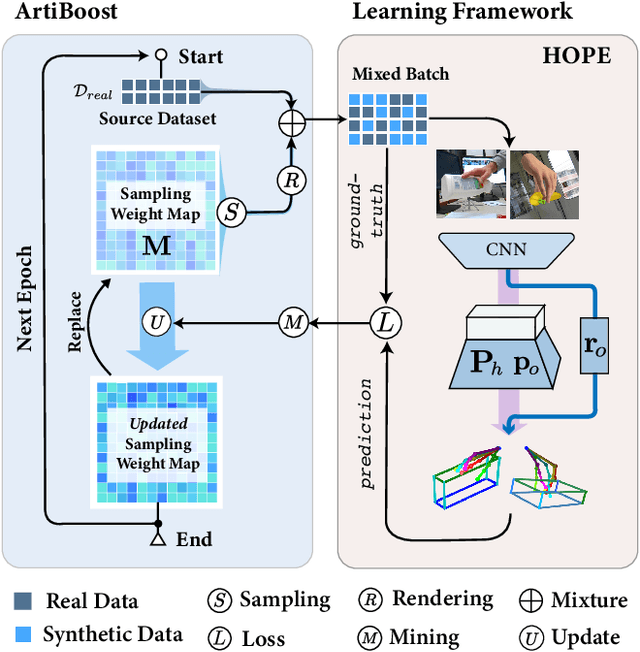
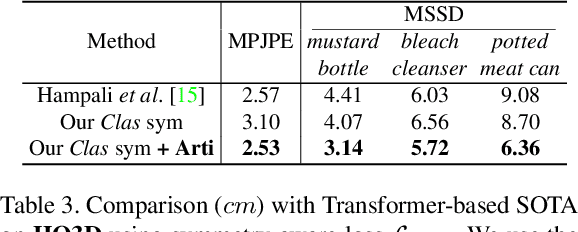
Abstract:Estimating the articulated 3D hand-object pose from a single RGB image is a highly ambiguous and challenging problem requiring large-scale datasets that contain diverse hand poses, object poses, and camera viewpoints. Most real-world datasets lack this diversity. In contrast, synthetic datasets can easily ensure vast diversity, but learning from them is inefficient and suffers from heavy training consumption. To address the above issues, we propose ArtiBoost, a lightweight online data enrichment method that boosts articulated hand-object pose estimation from the data perspective. ArtiBoost is employed along with a real-world source dataset. During training, ArtiBoost alternatively performs data exploration and synthesis. ArtiBoost can cover various hand-object poses and camera viewpoints based on a Compositional hand-object Configuration and Viewpoint space (CCV-space) and can adaptively enrich the current hard-discernable samples by a mining strategy. We apply ArtiBoost on a simple learning baseline network and demonstrate the performance boost on several hand-object benchmarks. As an illustrative example, with ArtiBoost, even a simple baseline network can outperform the previous start-of-the-art based on Transformer on the HO3D dataset. Our code is available at https://github.com/MVIG-SJTU/ArtiBoost.
 Add to Chrome
Add to Chrome Add to Firefox
Add to Firefox Add to Edge
Add to Edge